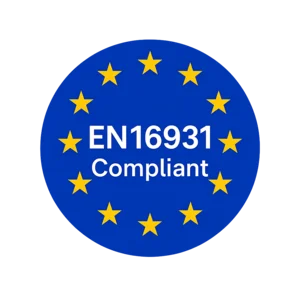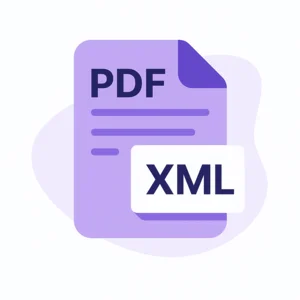Send invoices that meet European law – automatically.
The European Union is pushing for full digitization of business processes – especially invoicing. With Directive 2014/55/EU and national regulations (like Germany's starting in 2025), structured electronic invoicing will become mandatory across the EU.
- Invoices must be machine-readable and conform to the EN16931 standard
- Simplifies invoicing and reduces administrative costs
- Increases transparency and combats VAT fraud
- Streamlines public procurement across EU member states
- Supports digital transformation for businesses of all sizes
These changes are part of the EU's broader effort to modernize business processes and enable seamless cross-border commerce.

Compliant with EU Directive 2014/55/EU
EN16931 standard

Not just a PDF. A smart, structured invoice.
When we say "digital invoice," we don't just mean sending a PDF by email. A true electronic invoice is a file that your accounting software can read and process automatically — without manual typing or scanning.
That's why the EU requires standardized formats like ZUGFeRD and Factur-X, which embed a machine-readable XML file directly inside a human-readable PDF.
It looks like a normal invoice to you, but for accounting systems, it's a fully structured dataset. This ensures accuracy, automation, and compliance with legal requirements.
The legal side – made simple.
- Directive 2014/55/EU: All EU member states must support e-invoicing in public procurement.
- Germany (from 2025–2028): B2B e-invoicing becomes mandatory in phases.
- France, Italy, Poland, and others: Similar rollouts already underway.
- Accepted formats: ZUGFeRD, Factur-X, XRechnung, Peppol BIS 3.0
You're already prepared.
When you send invoices using docs101, they're:
- ✔ PDF/A-3 format with embedded XML
- ✔ 100% compliant with ZUGFeRD and Factur-X
- ✔ Accepted by public and private recipients across the EU
Frequently asked questions
What is the difference between ZUGFeRD and Factur-X?
Technically, they are identical. ZUGFeRD is the German name, Factur-X is the French equivalent. Both describe a hybrid PDF with embedded XML conforming to the EN16931 standard.
Is this legally required for freelancers?
Yes, starting in 2027 in Germany, all businesses — including freelancers — must send electronic invoices for B2B transactions. Other countries follow similar rules.
Do I have to register with Peppol?
Not necessarily. Peppol is mandatory for certain B2G (business to government) processes in some EU countries, but for B2B or hybrid formats like ZUGFeRD/Factur-X, registration is not required.
What exactly is EN16931?
EN16931 is the European standard that defines the semantic data model for electronic invoices. It specifies which information must be included in a compliant e-invoice, such as invoice lines, seller/buyer identifiers, VAT breakdowns, and payment details. This ensures consistent interpretation of invoices across accounting systems in all EU member states. It is the foundation for formats like ZUGFeRD, Factur-X, and XRechnung.
From when is electronic invoicing mandatory, and for whom?
EU Directive 2014/55/EU mandates e-invoicing in public procurement since 2019. In Germany, B2B electronic invoicing becomes mandatory in phases: From January 1, 2025: Businesses must be able to receive e-invoices. From January 1, 2026: Obligation to send e-invoices for larger companies. From January 1, 2027: Applies to all businesses, including freelancers. Legal references: German Federal Ministry of Finance and official EU documentation on Directive 2014/55/EU.